
The Island
The Palaeolithic
The Mesolithic
The Neolithic
The Bronze Age
The Iron Age
The Romano-British Period
The Anglo-Saxon Period
The Medieval Period

Museum Guide
The Archaeology of the
Isle of Thanet - An Introduction
The Island
The Isle of Thanet is situated at the
south eastern corner of Britain
and covers an area of approximately 40 sq miles.
By circa
5500 BC rising sea
levels formed the Wantsum Channel separating
Thanet from the rest of Kent. Measuring 4km at its widest
extent the Wantsum was crossed in medieval times and
probabaly earlier, by a ferry at Sarre.
By 1650 AD the Wantsum channel had
silted up so far that it was no
longer navigable
by the larger vessels of the day (Perkins 1999a: 148), today the river
Stour and a brook that still bears the name Wantsum are all that remain
of this once important sea lane.
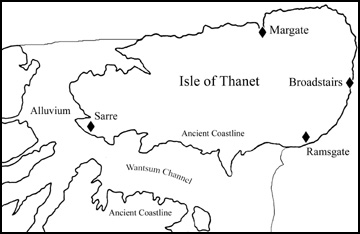
As well as the silting of the Wantsum
Channel the Isle of Thanet has
also been affected by coastal erosion of the chalk cliffs. One estimate
of this erosion puts the rate of loss at thirty metres per century
(Perkins 1999a: 150).
The prehistoric coastline of the Isle of
Thanet was very different from how it is today; much of the archaeology of the
earliest periods has been lost to coastal erosion or to rising
sea levels.
Despite this Thanet is an area with a
rich archaeological
heritage,one estimate is Thanet has 37% of all known crop
marks of archaeological sites in Kent despite only constituting 2.25%
of the Kent land area
(Perkins 1999b: 20).
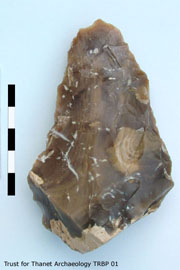
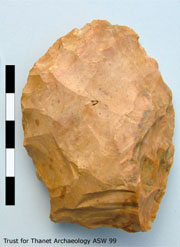
The Palaeolithic (Old Stone Age)
covers the period from 500,000 years
before present to around 10,000 BC; it is during this vast expanse of
time that modern man will have first come to what is now the Isle of
Thanet.
Although there are no known or excavated
occupation sites for this
period a number of finds from across Thanet attest to the presence of
hunter-gatherers during the Palaeolithic period.
A pointed Acheulian handaxe
found at the Thanet Reach Business Park (Pictured Left - top) and a
twisted ovate handaxe (Pictured Left - bottom)
from the excavations at ASDA store Westwood (ASW 99) are examples
of flint tools from this period.
Visit Palaeolithic Gallery
The Mesolithic
During the Mesolithic (Middle Stone Age)
period from 10,000 BC too
4,000 BC the hunters
learnt to exploit new food sources such as shellfish, vegetable foods
and forest animals like deer, wolf and bear (Perkins et. al. 1987: 6).
These changes in subsistence practices meant that there was also a
change in the types of flint tools produced during the Mesolithic. A
number of these smaller microliths have been found during the
excavations at the Thanet Reach Business Park (TRP 96).
Visit Mesolithic Gallery
The Neolithic
A number of important changes occur
during the Neolithic (New Stone
Age) period
(4,000-2300 BC), chief among them is the change from hunting and
gathering to settled farming communities that grew their own crops and
herded their own animals.
Of equal importance is the adoption of
pottery which becomes, along with flint, the most common type of
artefact found on archaeological sites in Thanet.
This more settled way
of life allowed for an increase in the population, which is reflected
in an increase in the number of sites found across Thanet. As well as
an increase in the number of sites there is also a greater variation in
the types of site found, as well as occupation sites, isolated burials
and field systems we also see towards the end of the Neolithic period
the construction of the burial mounds known as round barrows across
Thanet.
One of the earliest occupation sites to have been excavated is the causewayed
enclosure
discovered during the construction of the Ramsgate Harbour Approach
Road by Canterbury Archaeological Trust.
Some of the most impressive excavated
Neolithic round barrows are from
the
excavations at the Lord of the Manor, Ramsgate (LOM 77) where a total
of seven
round barrows were discovered. One of these barrows may even be a henge
monument.
The appearance of these monuments in the
Thanet landscape
indicates a level of social organisation in the Neolithic beyond that
found in earlier periods.
The large number of round barrows found
across Thanet, one estimate puts the number at 138 (Perkins 1987: 10),
suggest that the Isle was a centre of local or even regional importance
in the Neolithic period.
Visit Neolithic Gallery
Many of the developments in the later
Neolithic continue into the
Bronze Age, there is for example evidence for the reuse of some
Neolithic round barrows into the Bronze Age period (Macpherson-Grant
1980: 11).
The major development in the Bronze Age
(2300-700 BC) is the
introduction and development of bronze technology like the ability to
cast objects such as the Bronze axe head pictured below, accompanying
this is
a further rise in the scale and complexity of settlements across the
Isle of Thanet.

The site of South Dumpton Down (SDD 94)
was extensively excavated and
revealed a site with Middle Bronze Age and Late Bronze – Early Iron Age
occupation. Other excavated sites found across Thanet with Bronze Age
activity included Manston Road Ramsgate (MRR 04) and Monkton Court Farm
(MCF 92) where the discovery of a hoard of bronze objects led to an
evaluation of the site.
Other Bronze Age hoard sites include the
Birchington hoard and the St Mildreds Bay hoard (Perkins 1999a: 60-88).
The Iron Age (700 BC-43 AD) saw the
construction of a number of large
hill fort sites across Thanet, one of the largest being North Foreland
Broadstairs (NFB99/03).
These large sites once thought of as
defended
strongholds are now seen as having served the focus of occupation in an
area and would have operated as centres for the exchange of goods, for
religious practices and as the centre of power for the local
chieftains.
As well as the larger hill fort sites
like North Foreland
other important sites like South Dumpton Down (SDD 94) also contain
phases of Iron Age occupation showing that the Isle of Thanet was well
populated by the Iron Age with people living in both large and small
settlements across the island.
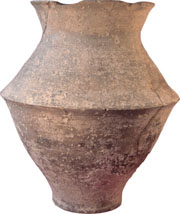
The Romano-British Period
With the gradual exposure of southern
Britain to the influence of
the Roman
Empire in the early 1st Century, the Isle of Thanet became incorporated
in a world trade system
that spread across the Mediterranean and even beyond into Africa
and Asia.
Although
there had been much contact between the prehistoric inhabitants of
Thanet and their neighbours in both Kent, France and the Low Countries
it is during the Romano British period (43-450 AD) that the Isle of
Thanet benefited from being on a key trade route from the Thames
Estuary
to the Roman Province of Belgica (Perkins 1987: 25).
Some of the best evidence for this
contact in Thanet comes from the
Roman Villa
site at Abbey Farm Minster (AFM96-99, 01-04). This long running
training and research excavation has led to the discovery of a
substantial villa complex that was at the centre of an estate possibly
supplying the Roman town and forts at Richborough and Reculver.
Features such as the two chambered malt kiln dating to the 4th century
pictured below have proved that Thanet was at the heart of Roman
Britain.
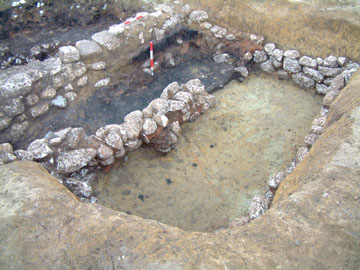
Other
notable
sites of the Roman Period on Thanet include the Tivoli Villa in Margate
and newly discovered settlement and buildings near Bishops Avenue
(BAB 04) and Stone Road at North Foreland, Broadstairs (SNB 04).
The main evidence of the Anglo-Saxon
period in Thanet
(450-1066 AD) is
the large
number of extensive and early period cemeteries that are found all over
the Island.
The largest of
these such as Ozengell or Lord of the Manor (LOM 77) is one of the most
important Anglo-Saxon cemeteries in the country, but there are
many other burial sites that are of equal value to aiding our
understanding of
Anglo-Saxon Thanet; these include the St Peters Refuse Destructor site
and recent discoveries of a small grave group by Wessex Archaeology at
Cliffsend Farm.
There is much less evidence for
occupation during the Anglo-Saxon
period, as well as a number of Saxon graves a range of
Anglo-Saxon settlement features were
found during the construction of the Sarre Pipeline (SSL 90).
During
the construction of a Tesco store in Manston Road, Ramsgate during
1996-7 a total of five Anglo-Saxon sunken floored buildings and
associated features were excavated by Wessex Archaeology providing some
insight into the
settlement pattern during this period of the islands past. Excavations
by the Trust for Thanet Archaeology at Woodchurch, Thanet uncovered
another Saxon Sunken Floored Building with pottery, an Iron knife
and fragments of a bone comb.
The Medieval PeriodEvidence for Medieval Thanet (1066-1547
AD) comes from many sites on
which whole or parts of the original buildings still survive.
One such site is
Salmestone Grange (SMG 79) where excavations in the ground of the
building uncovered a number of features from the medieval period.
Excavations in 1978 also uncovered the
remains of All Saints Church in
Shuart (ASS 78) an abandoned medieval village in western Thanet.
Recently excavations at East Northdown
(ENF 04) have uncovered
structures dating from the 13th to 17th centuries.
The letter and number combination in brackets - eg (ENF04) represent Site Codes employed by the Trust for Thanet Archaeology.
Oliver Gardner
Version 1 - Posted 23.03.05
All
content © Trust for Thanet Archaeology